How to Prepare Potting Soil for Fruit Trees: 3 Simple Steps
-
Codee Chessher
- Last updated:

Fruit trees are both beautiful and practical, bearing delicious fruit year after year once mature. Your native soil might support a fruit tree on its own but preparing your own potting soil blend will help give your fruit tree the best possible head start at life it can have. Let’s check out what you’ll need to craft this potting soil and how to go about it, step-by-step.

Before You Begin
Fruit trees all have specific quirks, but most do well in fertile, moist soil that drains well and with a pH between 5.5 and 7.0. This gives you quite a bit of wiggle room, but you must also consider your native soil. If it’s very compacted clay soil, for instance, you’ll have to make more soil to combat drainage issues. Similarly, excessively sandy soil holds few nutrients and drains too quickly for fruit trees, which like to soak up moisture over time.
The key to any good potting soil is balance. You can accomplish this in a lot of ways, but we’ve put together a pretty good recipe you can adapt to fit your fruit tree’s unique needs—some are pickier than others about growing conditions. Let’s check the ingredients down below.
- Vessel to house your potting soil
- Commercial potting soil (base)
- Peat moss
- Compost
- Perlite
- Coarse sand
- Leaf mulch
- Lime (optional for acidic soil)
Once you’ve gathered all your supplies, it’s time to mix up your fruit tree potting mix. Read on for the step-by-step guide and why we specifically included these ingredients.

How to Prepare Potting Soil for Fruit Trees: 3 Steps
1. Add Peat Moss & Compost for Nutrients

Take your commercial potting mix and pour it into your vessel of choice, then grab your peat moss and compost. Add 1 part of peat moss and compost to every 2 parts of soil. If your particular fruit tree likes alkaline soil, like fig or cherry trees, you can add lime to the hole before planting to help bring the pH level up. However, the majority of fruit trees do better in slightly acidic soil.
Peat moss retains both moisture and provides nutrients to the soil as it decomposes, and it also helps improve soil structure. It helps to break up compacted clay and improve drainage to sandy soil, so it’s a pretty balanced ingredient here.
Compost is commonly called black gold by gardeners because it’s beneficial for virtually all plants. While it appears like a thicker, black soil-like substance, compost starts life as organic material that’s left to decompose.
Air, heat, microbes, and beneficial insects all come together to break compost down into the nutrient-dense black gold we use for plants. Compost is useful for its nutrients, but it also improves soil structure and drainage. Most compost is acidic, which is perfect for your fruit tree. Compost is also thought to enhance fruit yields and flavor.
2. Add Perlite & Coarse Sand for Drainage

Add about 1 part perlite to every 4 parts of compost and add a cup of coarse sand. Together, these will help improve drainage in the soil, but they each have unique characteristics.
Perlite is the Styrofoam-looking pieces in most commercial potting soils, which is a lightweight inert material that doesn’t hold water or nutrients. Coincidentally, that makes it perfect for preventing soil compaction and keeping soil airy.
Coarse sand is just really chunky sand, but it’s important to make the distinction between coarse and fine sand. Fine sand leaves no room for air for water to flow through, actually hindering drainage. Coarse sand creates a giant network of tiny air pockets that oxygen and water can flow through to your plant’s roots.
3. Mulch With Leaf Mold

Right after planting, you need to protect your fruit tree’s roots and the fancy soil you just made. Some people warn you against mulching, but it’s typically beneficial. Some people like hardwood chips or shredded paper, but we like leaf mold because it’s both free and beneficial.
You can make leaf mold by simply leaving your leaves in the yard when they fall from your fruit tree. You can also rake the leaves from nearby leaves to within the drip line of your fruit tree to help improve coverage. Leaf mold shields the soil from direct sunlight, which preserves soil moisture and keeps root temperatures stable. It also helps cultivate beneficial soil fungi that work with your fruit tree’s roots!

Conclusion
Fruit trees might do fine in your yard but giving them a tailor-made potting soil blend will absolutely make a huge difference in your tree’s health and fruit yields. There are many other soil amendments you can add depending on your specific tree and native soil, but this is a great starting point to start with.
Featured Image Credit: bepsy, Shutterstock
Contents